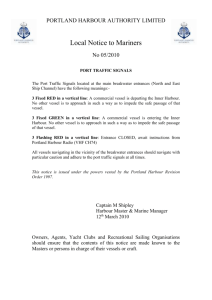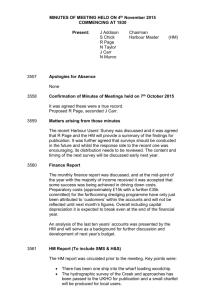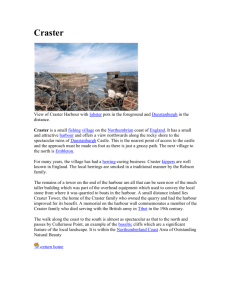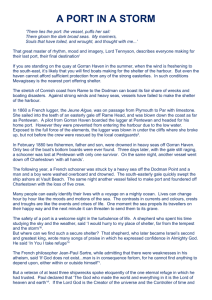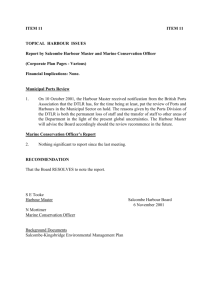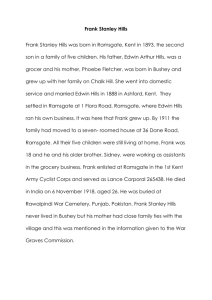6 Ports and Harbours
advertisement
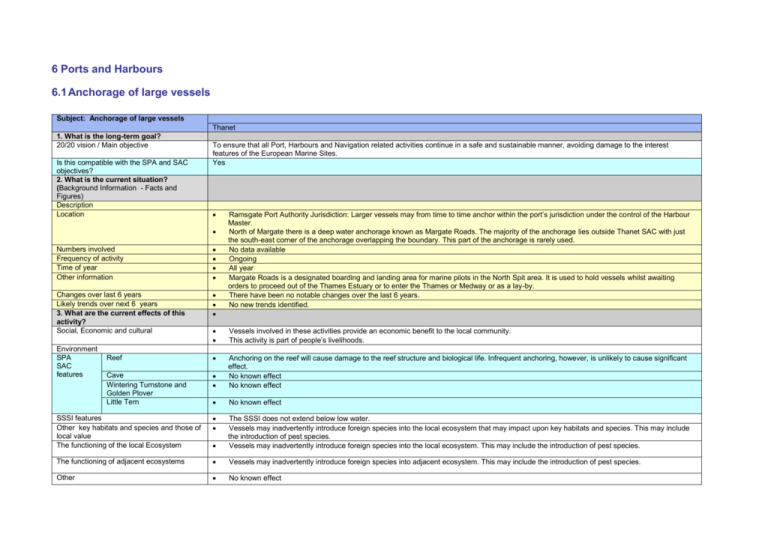
6 Ports and Harbours
6.1 Anchorage of large vessels
Subject: Anchorage of large vessels
Thanet
1. What is the long-term goal?
20/20 vision / Main objective
Is this compatible with the SPA and SAC
objectives?
2. What is the current situation?
(Background Information - Facts and
Figures)
Description
Location
To ensure that all Port, Harbours and Navigation related activities continue in a safe and sustainable manner, avoiding damage to the interest
features of the European Marine Sites.
Yes
Numbers involved
Frequency of activity
Time of year
Other information
Changes over last 6 years
Likely trends over next 6 years
3. What are the current effects of this
activity?
Social, Economic and cultural
Ramsgate Port Authority Jurisdiction: Larger vessels may from time to time anchor within the port’s jurisdiction under the control of the Harbour
Master.
North of Margate there is a deep water anchorage known as Margate Roads. The majority of the anchorage lies outside Thanet SAC with just
the south-east corner of the anchorage overlapping the boundary. This part of the anchorage is rarely used.
No data available
Ongoing
All year
Margate Roads is a designated boarding and landing area for marine pilots in the North Spit area. It is used to hold vessels whilst awaiting
orders to proceed out of the Thames Estuary or to enter the Thames or Medway or as a lay-by.
There have been no notable changes over the last 6 years.
No new trends identified.
Vessels involved in these activities provide an economic benefit to the local community.
This activity is part of people’s livelihoods.
Reef
Cave
Wintering Turnstone and
Golden Plover
Little Tern
Anchoring on the reef will cause damage to the reef structure and biological life. Infrequent anchoring, however, is unlikely to cause significant
effect.
No known effect
No known effect
No known effect
SSSI features
Other key habitats and species and those of
local value
The functioning of the local Ecosystem
The SSSI does not extend below low water.
Vessels may inadvertently introduce foreign species into the local ecosystem that may impact upon key habitats and species. This may include
the introduction of pest species.
Vessels may inadvertently introduce foreign species into the local ecosystem. This may include the introduction of pest species.
The functioning of adjacent ecosystems
Vessels may inadvertently introduce foreign species into adjacent ecosystem. This may include the introduction of pest species.
Other
No known effect
Environment
SPA
SAC
features
Subject: Anchorage of large vessels
4. What is the current management?
Organisations responsible for management
Key Documents
Existing Management
5. Will this management get us to where
we want to go – if not why not?
Will current management deliver the long
term vision for this activity
Will current management mean the
ecosystem can support this activity over the
long term?
Gaps in management
Gaps in management in relation to the SPA
and SAC features
Thanet
Margate Roads anchorage is outside the jurisdiction of the Port of London Authority. Because it is situated within UK territorial waters it can be
used by vessels without restrictions and is under the control of the Secretary of State for Transport.
Ramsgate Port Authority
Thanet District Council as Harbour authority
None identified
Ramsgate Port Authority is empowered under the Ramsgate Corporation Act 1934 and the Harbours and Piers Act 1847 plus other relevant
marine statutes. Vessels within the Ramsgate Port Authority Jurisdiction, including within the SAC, are controlled by this legislation.
Yes
Yes
None identified
Anchorage of large vessels within the SAC is not thought to be significant and does not necessitate management measures.
6.2 Dredging
Subject: Dredging
Thanet
1. What is the long-term goal?
20/20 vision / Main objective
Is this compatible with the SPA and SAC
objectives?
2. What is the current situation?
(Background Information - Facts and
Figures)
Description
Maintenance dredging within the European marine sites occurs in a sustainable manner that avoids any adverse impacts on the features of
importance in the area.
Yes
Location
Frequency of activity
Time of year
Other information
Changes over last 6 years
Likely trends over next 6 years
3. What are the current effects of this
activity?
Maintenance dredging occurs in this area to maintain the Ramsgate Port approach channel. It involves the removal of sediment from the
channel, which is then disposed of at sea at a particular location.
Dredging occurs within the Ramsgate Port Authority jurisdiction. In particular the Port approach channel and in the port and harbour. Material is
disposed of at MAFF licensed disposal sites TH140 at Pegwell Bay and in the past at Ramsgate main sands TH145.
Dredging and disposal is ongoing
Throughout the year and as required
TDC as Port and Harbour authority have a licence to dispose of the material dredged from the Port and Harbour. The current licence stipulates
that the total quantity to be disposed of at the site must not exceed 66,367 tonnes at TH140 Pegwell Bay.
In the past clean sand has been deposited under licence on Ramsgate main sands but it is unlikely this site will be used again.
None identified
Likely to remain the same.
Subject: Dredging
Social, Economic and cultural
Environment
SPA
SAC
features
Reef
Cave
Wintering Turnstone and
Golden Plover
Little Tern
Thanet
Maintenance dredging ensures that there remains a functioning Port – which provides many social and economic benefits for both the local and
wider community.
Disruption to benthic communities.
Possible temporary water quality issues – increased levels of suspended sediment in the water column.
Chance of re-suspension of contaminated sediments – this, however, is monitored closely before consenting the disposal of dredgings to sea.
The Ramsgate Port approach channel has been surveyed (Ref Natural England). The base of the cut channel supports an impoverished
scoured community of no particular nature conservation importance. The reef on either side supports good examples of species rich
communities.
Potential smothering of chalk reef habitat
None identified
None identified
None identified
Potential limiting effects on sediment supply for dunes
SSSI features
Other key habitats and species and those of
local value
The functioning of the local Ecosystem
SSSI does not extend below mean low water mark
Fines (fine sediment) in the water affect fish and fish pathways
Removal of sediment from they system does affect the natural functioning of the local ecosystem
The functioning of adjacent ecosystems
Disposal sites are affected – potential for contamination
Altered benthic community at disposal sites
Key Documents
Existing Management
Dunes (feed sediments)
4. What is the current management?
Organisations responsible for management
5. Will this management get us to where
we want to go – if not why not?
Will current management deliver the long
term vision for this activity
Will current management mean the
ecosystem can support this activity over the
long term?
Gaps in management
Gaps in management in relation to the SPA
and SAC features
6. What, if anything, do we want to do?
Management measures, policies, actions,
Ramsgate Port Authority – dredging
Marine Consents and Environment Unit – a Food and Environmental Protection Act Licence is required for disposal of dredgings at sea
Thanet District Council as Harbour Authority
CEFAS document – “The impact of disposal of marine dredged material on the Thanet Coast and Sandwich Bay Candidate Special Area of
Conservation”.
Dredging licences are issued by MCEU on a yearly basis and are strictly controlled. If deemed necessary environmental impact studies take
place before licences are issued. An assessment of disposal operations has been completed (CEFAS Contract ReportAA001 Feb 2001). It
included consideration of the effect of disposal on dune feed sediments and considered there would be no adverse effect arising from the
disposal.
Ramsgate Port Authority submits records of dredging disposals to MCEU on a six monthly basis.
New Plans or Projects: Any proposed new operations including capital dredging works will be subject to Regulation 48.
Possibly not as there may be issues about sediment budgets
It needs to be reviewed in combination with management of coastal process and other human interventions in the systems
None identified
None identified
What
Who
Subject: Dredging
New ideas or solutions and who will action
Management Measures for SPA and SAC
features
Thanet
None required at this time
None required at this time
6.3 Navigation Buoys and recreational buoys
Subject: Navigation Buoys
Thanet
1. What is the long-term goal?
20/20 vision / Main objective
Is this compatible with the SPA and SAC
objectives?
2. What is the current situation?
(Background Information - Facts and
Figures)
Description
Location
Frequency of activity
Time of year
Other information
Changes over last 6 years
Likely trends over next 6 years
3. What are the current effects of this
activity?
Social, economic and cultural
SPA
Reef
SAC
features
Cave
Wintering Turnstone and
Golden Plover
Little Tern
SSSI features
Other key habitats and species and those of
local value
The functioning of the local Ecosystem
To ensure that all Port, Harbours and Navigation related activities continue in a safe and sustainable manner, avoiding damage to the interest
features of the European marine sites.
Yes
Navigation and recreational buoys
Navigation Buoys both temporary and permanent are shown on Admiralty Charts
Some navigation buoys are permanent and are in place all the time, temporary racing buoys are placed out for seasonal sailing
The temporary buoys are placed out from April to September
Numerous leisure craft operate in the area during the summer
There have been no notable changes over the last 6 years
No new trends identified
Enhances safety
Navigation buoys and temporary racing buoys are anchored on the reef but not known to have a significant impact on the features of
European importance
No effect
No effect
No effect
The SSSI does not extend below low water
No effect
No effect
The functioning of adjacent ecosystems
No effect
Other
4. What is the current management?
Organisations responsible for management
No effect
Navigation buoys within the jurisdiction of Ramsgate Port are the responsibility of Ramsgate Port Authority
Winter Stoke beacon is the responsibility of Southern Water Services
Subject: Navigation Buoys
Key Documents
Existing Management
5. Will this management get us to where
we want to go – if not why not?
Will current management deliver the long
term vision for this activity
Will current management mean the
ecosystem can support this activity over the
long term?
Gaps in management
Gaps in management in relation to the SPA
and SAC features
Thanet
Other buoys are the responsibility of Trinity House
Temporary racing buoys are owned and managed by Royal Temple Yacht Club
Shipwrecked craft above low water are the responsibility of TDC
Below the low tide mark shipwrecked craft are the responsibility of Trinity House
None identified
The position of buoys, including temporary ones, are located and approved by Trinity House and the Harbour Authority as the local
lighthouse authority
Yes
Yes
None identified
None identified
6.4 Port and harbour operations
Subject: Port and harbour operations
Thanet
1. What is the long-term goal?
20/20 vision / Main objective
Is this compatible with the SPA and SAC
objectives?
2. What is the current situation?
(Background Information - Facts and
Figures)
Description
Location
Numbers involved
Frequency of activity
Time of year
To ensure that all Port, Harbours and Navigation related activities continue in a safe and sustainable manner, avoiding damage to the interest
features of the European marine sites.
Yes
Includes vessel use, fuel storage, waste disposal and general marina operations.
Ramsgate Port and harbour, Broadstairs Harbour, Margate harbour, Sandwich Port and Haven.
Record of vessel traffic is kept by the Ramsgate Port Authority for the area within their jurisdiction. 1500 tonnes of waste is disposed of by
Thanet District Council from visiting boats and boats operating in the harbour.
In constant use
In constant use
Activity of recreation and leisure craft increases significantly from March to September
Subject: Port and harbour operations
Other information
Changes over last 6 years
Likely trends over next 6 years
3. What are the current effects of this
activity?
Social, economic and cultural
Thanet
The ongoing activity in the ports and harbours includes the following:
Use by large commercial ferries
Use by small commercial coastal vessels
Use by commercial fishing vessels
Use by leisure craft
Fuel storage
Discharge of waste water from small vessels
Maintenance dredging of Ramsgate Port and channel (see Dredging)
Marina operations
(Anchorage and navigation are mentioned separately)
None identified
No new trends identified
Operations provide economic benefits to the local community
Employment
Can be interesting places for people to visit
Tourism
Existing use of the Ports and harbours is not known to be causing significant disturbance to the features of European interest
No known effect
No known effect
No known effect
The SSSI does not extend below low water
Vessels may inadvertently introduce foreign species into the local ecosystem that may impact upon key habitats and species. This may include
the introduction of pest species.
Vessels may inadvertently introduce foreign species into the local ecosystem. This may include the introduction of pest species.
The functioning of adjacent ecosystems
Vessels may inadvertently introduce foreign species into adjacent ecosystem. This may include the introduction of pest species.
Other
4. What is the current management?
Organisations responsible for management
No known effect
SPA
SAC
feature
s
Reef
Cave
Wintering Turnstone and Golden
Plover
Little Tern
SSSI features
Other key habitats and species and those of
local value
The functioning of the local Ecosystem
Key Documents
Existing Management
Thanet District Council as Port Authority
Sandwich Port and Haven Commissioners
Margate Pier and Harbour Company (inactive)
Marine and Coastal Agency
Kent County Council Emergency Planning
Dover District Council
None identified
Ongoing activities are carried out under the following regulations and controls:
Harbour acts
Waste Management plans
Waste Water Regulations
Marine Pollution Controls
Harbour Emergency Plan
Port Safety Management Plan
Ship waste: TDC operates a Waste Management Plan which is submitted to the Marinas and Coastguard Agency for their approval. Oil from
Subject: Port and harbour operations
Thanet
ships bilges is taken away by an operator licensed by the Environment Agency. MARPOL Regulations for the disposal of sewage Annex 5 (solid
waste) is controlled by the Ports Waste Management Plan.
New plans or projects: Any proposed new operations will be subject to Regulation 48.
5. Will this management get us to where
we want to go – if not why not?
Will current management deliver the long
term vision for this activity
Will current management mean the
ecosystem can support this activity over the
long term?
Gaps in management
Gaps in management in relation to the SPA
and SAC features
Yes
Yes
None identified
None identified
6.5 Emergency spill contingency
Subject: Emergency spill contingency
Thanet
1. What is the long-term goal?
20/20 vision / Main objective
Is this compatible with the SPA and SAC
objectives?
2. What is the current situation?
(Background Information - Facts and
Figures)
Description
Location
Numbers involved
Frequency of activity
Time of year
Dover
Canterbury
To ensure that an effective emergency spill response is in place to avoid major impacts from possible spills.
Yes
Emergency spill contingency planning
Anywhere – but higher probability around
Anywhere – but Dover harbour, Sandwich
Anywhere – but Whitstable or Herne Bay
Ramsgate harbour and within eastern
Port and Haven, and Eastern English
harbours and Eastern English Channel or
English Channel shipping lanes.
Channel are higher probability
Thames estuary are higher probability
Few – only takes two vessels to collide; or minor spills from incidents (from tank flushing, to WWII wrecks leakage).
Rare
One major – 2002 in French Channel 30 miles east of Ramsgate.
Minor oil pollution – a few every winter
Anytime – but minor oil spills reported usually in winter from December to March.
Subject: Emergency spill contingency
Other information
Changes over last 6 years
Likely trends over next 6 years
3. What are the current effects of this
activity?
Social, economic and cultural
Environment General
SPA
SAC
features
Reef
Cave
Wintering Turnstone and
Golden Plover
Little Tern
SSSI features
Other key habitats and species and those of
local value
The functioning of the local Ecosystem
The functioning of adjacent ecosystems
Other
4. What is the current management?
Organisations responsible for management
Key Documents
Thanet
Dover
Canterbury
Major incidents co-ordinated by MCA in conjunction with all local authorities & rescue agencies.
MCA also working on a number of issues related to environmental protection, the major topics being addressed are:
Ballast Water
Oil Tagging
Port Waste Reception Facilities
Sewage
Prevention of Oil Pollution
Marine Litter
Ship Recycling
Air Pollution
Anti-fouling / TBT
Last closest major incident – 30 miles west of Ramsgate in English Channel in winter of 2002/3 (Tricolor) – c21, 000 seabird casualties, with estimated
41,000-100 000 seabirds deaths (25 000-62 500 Guillemots, 8000-20 000 Razorbills – Birdlife Belgium, estimates).
Emergency spill contingency planning task was last held in 2002/3
Satellite navigation monitoring of oil spills in 2004 may have helped reduce oiled bird incidents in 2004/5 and 2005/6, but then Tricolor had already
removed large numbers of the seabird population.
The Eastern English Channel area is of high vulnerability to oil pollution incidents (notably in winter Dec-Mar).
Cost of clean up
Effect on local communities that are impacted by the spills
The potential impacts on the environment can be vast, ranging from oiled birds to habitat destruction.
The potential impacts on the environment can also be long lasting
Impacts on algal communities
Oiled birds
Oiled birds
Oiled birds
There are sporadic problems of ships releasing oil and oil birds at sea
The potential impacts on the local ecosystem can be vast, ranging from oiled birds to habitat destruction.
The potential impacts can also be long lasting
The potential impacts on adjacent ecosystems can be vast, ranging from oiled birds to habitat destruction.
The potential impacts can also be long lasting
See above
MCA
MCA
Kent Police
Kent Police
KCC
KCC
TDC Maritime + Coastal Engineers +
DDC +
Foreshore + Emergency Planning +
NE
Environmental Health
KWT & TCP – for advice
NE
TCP – for advice
Emergency Plan in place
DDC/Dover Harbour Authority Emergency
guidelines
Oil Spill Contingency Guidelines (MCA)
MCA
Kent Police
KCC
CCC +
NE
KWT& TCP – for advice
CCC Whitstable Harbour Oil Spill Plan
Oil Spill Plan Major Emergency Plan
Subject: Emergency spill contingency
Thanet
TDC(Ramsgate harbour)Emergency
Guidelines
{Note: National plan was consulted upon from 06/06/05 to
Dover
Canterbury
05/09/05}.
Existing Management
5. Will this management get us to where
we want to go – if not why not?
Will current management deliver the long
term vision for this activity
Will current management mean the
ecosystem can support this activity over the
long term?
Gaps in management
Gaps in management in relation to the SPA
and SAC features
KCC Emergency Planning +TDC
TDC Maritime – contingency plan
Voluntary action – Thanet Seabird Rescue &
local vets; RSPCA.
TCWS – asked to report oil incidents.
TCP produce winter posters for display about
oiled seabirds and contact numbers.
TCP, NE and KWT are all local contacts for
nature conservation advice for major oil
pollution incidents under the emergency
plans.
Yes
Yes
None identified
None identified
KCC Emergency Planning + DDC?
Voluntary action – Thanet Seabird Rescue;
RSPCA
TCWS – asked to report oil incidents.
TCP, NE and KWT are all local contacts for
nature conservation advice for major oil
pollution incidents under the emergency
plans.
KCC Emergency Planning + CCC
Voluntary action – Thanet Seabird Rescue;
RSPCA
TCWS – asked to report oil incidents
TCP, NE and KWT are all local contacts for
nature conservation advice for major oil
pollution incidents under the emergency
plans.
